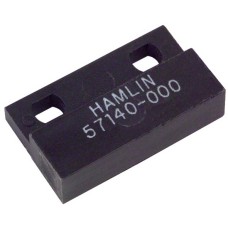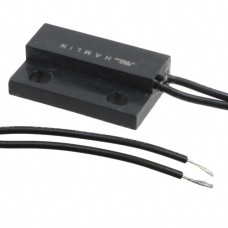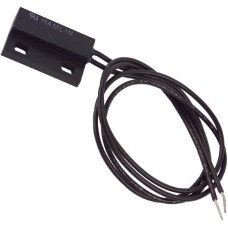Hamlin
Overview
These are inexpensive, very small magnetic reed sensors that can be used to sense the position of an airbrake or flap actuator or to sense that the landing gear is up or down and locked. They can be ordered in versions that are normally-open (no current flow when not activated, current flow when activated) or normally-closed (current flow when not activated, no current flow when activated).
Related Pages
- Mountain Switch - lever and roller-lever switches
Terminology
- NO (Normally Open) - current flow when activated, no current flow when not activated
- NC (Normally Closed) - no current flow when activated, current flow when not activated
Applications
- Airbrakes Locked
The goal is to have current flow when the airbrakes are not closed and locked (fully forward)- Use a normally closed sensor at the forward (airbrakes locked) position
- Landing Gear Down and Locked
The goal is to have current flow when the landing gear is not down and locked.- If the sensor is mounted in the gear down and locked position then use a normally closed sensor (recommended).
- If the sensor is mounted in the gear up position then use a normally open sensor.
- Flap Handle (Cruise/Climb)
The goal is to have current flow when the flap handle is in the climb range (flaps at +1 or greater) and no current flow when the flap handle is in the cruise region (flaps at -2, -1, 0). The magnet (or multiple magnets) is mounted on the flap actuator handle and the sensor is mounted on the cockpit sidewall.
Note: You may need to use several magnets (actuators) to make sure the switch is activated during the full travel of the flap handle in the desired range.- If the sensor is mounted in the cruise region of the flap handle's travel (flaps at -2, -1, 0) then use a normally closed sensor. (recommended)
- If the sensor is mounted in the climb region of the flap handle's travel (flaps at +1 or greater) then use a normally open sensor.
Switch Comparison
Magnetic reed sensors have some advantages and some disadvantages when compared with the mechanical lever switches. Note that both sensor types have moving parts - reed switches have small internal mechanical switches which have a finite life - just like mechanical lever switches do.
- Magnetic Reed Switch
- Advantage: Non-contact, no friction
- Disadvantage: A magnetic target (actuator) must be mounted on the item being sensed.
- Mechanical Roller Switch
- Advantage: The switch senses the actual item being sensed so no magnet needs to be mounted on the item being sensed.
- Disadvantage: Mechanical contact is required so there will be some friction in applications where the target is moving relative to the sensor.
Hamlin-57140-000 - Magnetic Actuator
Magnetic Actuator for use with 59140 SensorsThis is the magnetic target that is sensed by the 59140 ..
$9.00
Hamlin-59140-010 - Sensor, Magnetic-Reed, normally open, single pole, single throw (SPST)
Sensor, Magnetic Reed, Normally Open - With MagnetYou will need at least one 57140-000 Mag..
$9.00
Hamlin-59140-040 - Sensor, Magnetic-Reed, normally closed, single pole, single throw (SPST)
Sensor, Magnetic Reed, Normally Closed - With MagnetYou will need at least one 57140-000 M..
$9.00




